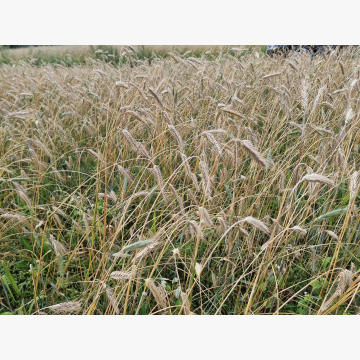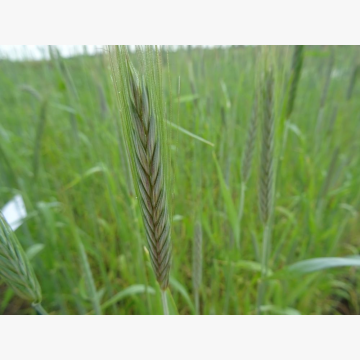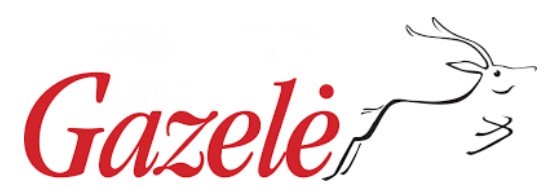- Home
- Seeds
- Fodder crops
- SM ELARA
FOR CONSULTATIONS APPLY TO:
Commercial director
Lina Smalskienė
tel. +370 618 02 551
e-mail linak@agrolitpa.lt
Sales manager
Tautvydas Kliučininkas
tel. +370 681 35 093
e-mail tautvydask@agrolitpa.lt
Sales manager
Eglė Petkevičienė
tel. +370 626 95 458
e-mail eglep@agrolitpa.lt
Sales manager
Kotryna Nakrošytė
tel.: +370 601 39 282
e-mail kotryna@agrolitpa.lt
SM ELARA
An early, high yielding, resistant to lodging and diseases alternative rye recommended for green fodder
- Maximum efficiency in green mass growing
- It stands out for high falling number, grain uniformity and high weight of hectoliter
- Suitable for growing of high-quality grains for the milling and baking industry, and well as for high-quality green fodder for cattle
- Sowing can be done both in autumn and spring (until May 15)
- One of the highest grain yields among registered spring rye varieties
- Average yield (in Poland) – 6.27 t/ha
- Grain yield (in Poland) – 4.9-5.0 t/ha, in other references – 5.9-6.1 t/ha (in 2020)
- High yield of green mass
- Green mass yield – 44.9 t/ha
- Dry matter yield – 10.79 t/ha
- Heading time – early
- Ripening time – early
- Plant height – 141 cm (medium)
- Resistance to lodging – high (7.1 points)
- Winter hardiness – good
- Tolerates drought very well
- Resistance to grain sprouting in ears – 5 (high)
- Grain uniformity – high
- Grain uniformity > 2.5 mm – 85 % (high)
- 1000 grain weight – 34.8 g
- Hectoliter weight – high (5 points)
- Protein content – medium (4 points)
- Falling number – high (6 points)
- Tolerates adverse conditions
- Grows well in poor soils
Resistance to diseases (when 6 – very resistant)
|
Mildew |
4-6 points |
Good/high |
|
Brown rust |
4 points |
Good |
|
Black rust |
5 points |
High |
|
Pyrenophora graminea |
6 points |
High |
|
Scald (rhynchosporium) |
4 points |
Good |
|
Leaf septoria |
4 points |
Good |
|
Fusarium on ears |
6 points |
High |
|
Rot disease (complex of Microdochium spp., Fusarium spp., Stagonospora nodorum, Bipolaris sorokiniana) |
4 points |
Good |
- SM ANANKE – 7.28 t/ha
- SM ELARA – 7.04 t/ha
- BOJKO – 6.71 t/ha
*Results of spring rye yield in the demonstration plots of Lodz agricultural consulting centre zs. Bratoszewice (collected on 13 August 2020)
- Grain yield in 2017 – 4.59 t/ha
- Grain yield in 2018 – 4.10 t/ha
- Grain yield in 2019 – 4.38 t/ha
- Grain yield in 2020 – 3.90 t/ha
- Plant height – 144 cm
- Resistance to lodging – 4.2 points (out of 9)
- Days to heading – 149 days
- Days to full maturity – 210 days
- 1000 grain weight – 32.8 g
- Grain uniformity – 80 %
- Crop density – 5 points (out of 9)
- Resistance to grain sprouting in ears – 5 points (out of 9)
- Falling number – high (6 points)
Resistance to diseases (when 9 – very resistant)
| Mildew | 7.7 ponts |
| Brown rust | 6.5 points |
| Pyrenophora graminea | 7.4 points |
| Scald (rhynchosporium) | 7.0 points |
| Leaf septoria | 6.3 points |
| Rot diseases | 7.1 points |
| Ergot (Claviceps purpurea) | 0.6 g/kg grain |
The varietal parameters may differ from those indicated here when the testing circumstances differ from quondam
Recommended sowing rate: 120-140 kg/ha for early sowing and 150-180 kg/ha for late sowing
Recommended sowing rate for fodder: 220-240 kg/ha when sowing in spring, and 200 kg/ha for sowing in autumn
Keravos sreet. 17, Kerava,
LT-38 131 Panevėžys district, LITHUANIA
Enterprise's code 168598128
VAT code LT685981219
Tel. +370 615 11 315
E. mail info@agrolitpa.lt






.JPG)

